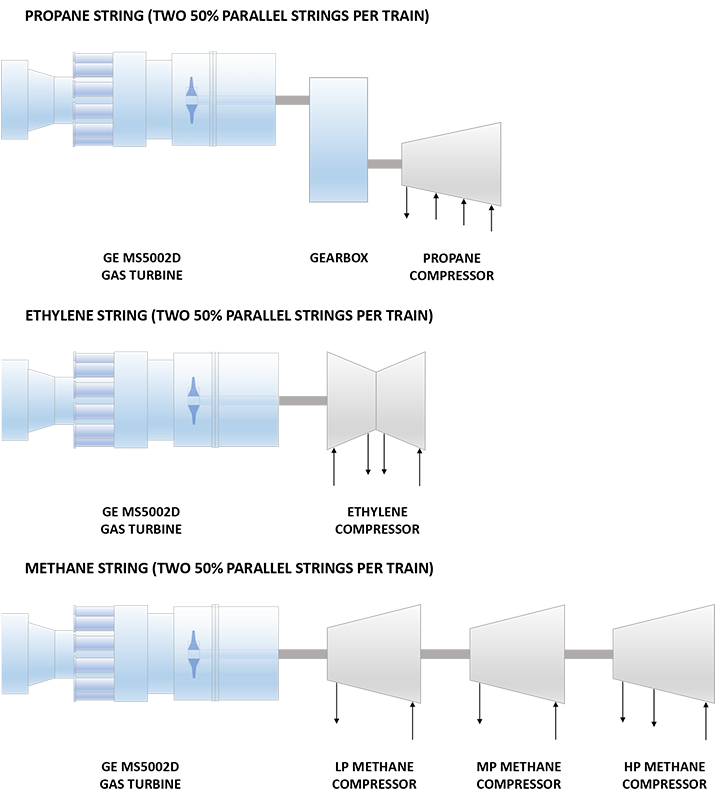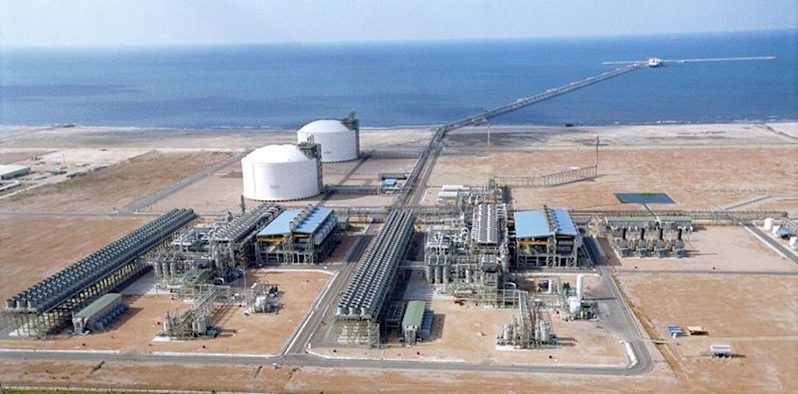In 1995, BG International Limited (BG) and Edison International (Edison) signed an agreement with Egypt for exploration in the West Delta Deep Marine (WDDM) region in the North Eastern Mediterranean. The success of the exploration and subsequent discovery of abundant gas reserves resulted in extension of the agreement to export LNG from the region.
Egyptian LNG Companies EGAS (12%) and EGPC (12%) together with BG (38%) and Petronas (38%) formed the El Behera Natural Gas Liquefaction Company to construct a $1.12 billion LNG plant at Idku, approximately 50 kms from Alexandria. A 20-year sale contract was signed with Gaz De France (GDF) in January 2002. Gas to the plant would be supplied from the Simian Sienna fields in WDDM. Construction of the project started in 2002 and 27 million construction man-hours resulted in shipment of first cargo on 29th May 2005, 6 months ahead of schedule.
In the meanwhile, Idku Natural Gas Liquefaction Company was formed for construction of a second train with similar capacity at the site. In September 2003, sale agreement for export of the entire capacity of the second train was signed with British Gas Company. First cargo of gas supplied from the Sapphire fields was dispatched from the second train on 15th September 2005, 9 months ahead of schedule. Incidentally the facility has ample space to accommodate up to 6 trains, each with unique ownership and independent source of gas supply.
ELNG claims high standards for its community engagement and has undertaken several local community projects for education on road safety, funding sustainable water supply and creating sustainable local community employment.1 It has also been involved with development of infrastructure for a Water Supply Project (WSP) and the Idku Community Centre (ICC). The company has employed local residents for a large number of security jobs as well as for maintenance and support service posts.2 Egyptian LNG also claims to have initiated sustainable management processes, including reducing material consumption, waste to landfill water and energy use.3
In 2014, political upheaval and increase in energy demand within Egypt resulted in diversion of the supply of gas from the export plant. By 2015, ELNG stopped exporting gas and resulted in Egypt becoming a net importer of LNG, from being a substantial exporter in previous years. Recent discovery of gas reserves in the Zohr gas field of the Mediterranean Sea as well as Egypt’s West Nile Delta, offer encouragement to Egypt’s LNG export aspirations and the reinstatement of ELNG to past glory.
OWNERSHIP (Equity %)
| Train 1 | |
| BG (now Royal Dutch Shell) | 35.50% |
| PETRONAS | 35.50% |
| Egyptian General Petroleum Corporation (EGPC) | 12.00% |
| Egyptian Natural Gas Holding Company (EGAS) | 12.00% |
| ENGIE (now TOTAL) | 5.00% |
| Train 2 | |
| BG (now Royal Dutch Shell) | 38.00% |
| PETRONAS | 38.00% |
| Egyptian General Petroleum Corporation (EGPC) | 12.00% |
| Egyptian Natural Gas Holding Company (EGAS) | 12.00% |
General Data
| Estimated Capital Cost (USD) | 1.35 B Par Train |
| Plant Type | Onshore Stick-built |
| Plant Stage | Operating |
| Final Investment Decision (FID) Year | 2001 |
| FEED Contractor | Bechtel |
| EPC Contractor | Bechtel |
| No. of Trains / capacity | 2 Trains / 3.6 MMTPA each |
| Production Start Year | 2005 |
| Products | LNG |
| Gas Type | Non-associated Gas (NAG) |
Technical Data
| Cooling Media | Air |
| Liquefaction Technology | CoP Optimized Cascade® |
| Refrigeration Train Details: | |
| Propane Strings 1 & 2 | |
| Driver | GE MS5432D (Frame 5D) Heavy Duty Gas Turbine |
| Gearbox | Double Helical speed reduction gearbox |
| Propane Compressor | 3MCL1405 GE (Nuovo Pignone) Horizontally Split Centrifugal Compressor |
| Ethylene Strings 1 & 2 | |
| Driver | GE MS5432D (Frame 5D) Heavy Duty Gas Turbine |
| Ethylene Compressor | 2MCL1006 GE (Nuovo Pignone) Horizontally Split Centrifugal Compressor |
| Methane Strings 1 & 2 | |
| Driver | GE MS5432D (Frame 5D) Heavy Duty Gas Turbine |
| Low Pressure (LP) Methane Compressor | MCL806 GE (Nuovo Pignone) Horizontally Split Centrifugal Compressor |
| Medium Pressure (MP) Methane Compressor | MCL806 GE (Nuovo Pignone) Horizontally Split Centrifugal Compressor |
| High Pressure (HP) Methane Compressor | 3BCL608 GE (Nuovo Pignone) Radially Split Centrifugal Compressor |
| Power Generation | 4 x Alstom GT35C (now Siemens SGT500) gas turbine generators |
Refrigeration Train Configuration

Key Facts
- With just six years from gas discovery to first LNG production, Egyptian LNG set a record in speed-to-market and became a trailblazer of World LNG projects.4
- In 2003, sale of Edison International’s share in Egyptian LNG and the upstream operations at WDDM to a subsidiary of PETRONAS (PICL Egypt), also secured extensive LNG experience for the project.5
- The Idku LNG port facilities include a Jetty with all its topside facilities, aids for navigation, Breakwater, Access channel, turning basin and berthing basin, which are capable of accommodating LNG vessels of capacity 40,000 m³ to 165,000 m³.6
- Since 2009, Egyptian LNG has received Gold Medals and awards recognized by ROSPA “Royal Society of Preventing Accident” for seven consecutive years for Health, Safety and Sustainable Development.7
- Egyptian LNG project optimized their design based on Trinidad & Tobago’s Atlantic LNG Trains 1-3 and selected a nominal train size of 3.6 MMTPA, which had become a standard towards the end of the 1990’s. This contributed to competitive capital costs, reduced project schedule and minimal owner’s risk.8
- Though Egyptian LNG followed the design of Atlantic LNG, several improvements and modifications were incorporated to optimize the plant and adapt to the regional conditions:8
- In 2006, plans to add a third LNG were underway. The facility has the ability to add up to four more trains i.e. a total of six trains.9
- ELNG is a free-zone company (no taxes & duties) and attracted foreign investments of $2 billion into Egypt. The project generates valuable export income for the country and contributes more than $1 billion in annual revenue across the value chain.9
- In 2014, the plant declared force majeure to its LNG customers on account of diversions of gas supplies to the local market. LNG exports plummeted from 50 shipments in 2013 to a paltry 5 shipments in 2015. Reportedly, the plant requires a minimum of 22 shipments annually to break even.10
- Egypt was forced to become a net LNG importer due to increasing domestic demand and shortage of gas, coupled with the country’s internal challenges. In 2018, encouraged by the discovery of abundant gas in Zohr field, the government declared that they had ceased LNG imports, saving $250 million per month.11
- BG had acquired a $2 billion loan for the Egyptian LNG project. In 2012, Egyptian General Petroleum Corporation (EGPC) had agreed to pay the first instalment of $480 million on account of halting operations in the past. By 2015, $1.4 billion had reportedly been paid back, through annual instalments of $200 million. In July 2017, a year after acquiring BG, Royal Dutch Shell repaid the final instalment of the loan ahead of schedule. 10,12
- In November 2017, Total acquired 5% stake in the first train from French energy company ENGIE.13
- In October 2018, Dragon LNG’s Milford Haven terminal in UK began receiving LNG from Egypt. Shell targeted exporting an LNG cargo every 15 days, with supplies from the offshore Burullus and Rosetta fields.14
Source:
1. ‘Social Performance Collaboration Forum’, Egyptian LNG website
2. ‘Egyptian LNG sets new standard’, LNG Journal website, 8 November 2006
3. ‘Environment’, Egyptian LNG website
4. ‘Egyptian LNG at a Glance’, Egyptian LNG website
5. ‘Historical Background’, Egyptian LNG website
6. ‘Port / Marine Facilities’, Egyptian LNG website
7. ‘News & Events’, Egyptian LNG website
8. ‘Egyptian LNG – The value of standardization’, Phil Redding, Rick Hernandez, Wesley R. Qualls and Amos Avidan, GASTECH 2005
9. ‘Egyptian LNG sets new standard’, LNG Journal website, 8 November 2006
10. ‘Idku plant LNG exportation collapses 2014’, Egypt Oil & Gas Newspaper website, 5 January 2015
11. ‘Egypt stops importing LNG‘,LNG World News, 1 October 2018
12. ‘Shell repays $2 billion Idku loan ahead of schedule‘, Energy Egypt website, 3 July 2017
13. ‘Total Acquires 5% Stake in Idku LNG Project‘, Egypt Oil & Gas Newspaper website, 9 November 2015
14. ‘UK to Receive Egyptian LNG Cargo‘, Egypt Oil & Gas Newspaper website, 28 October 2018






















































